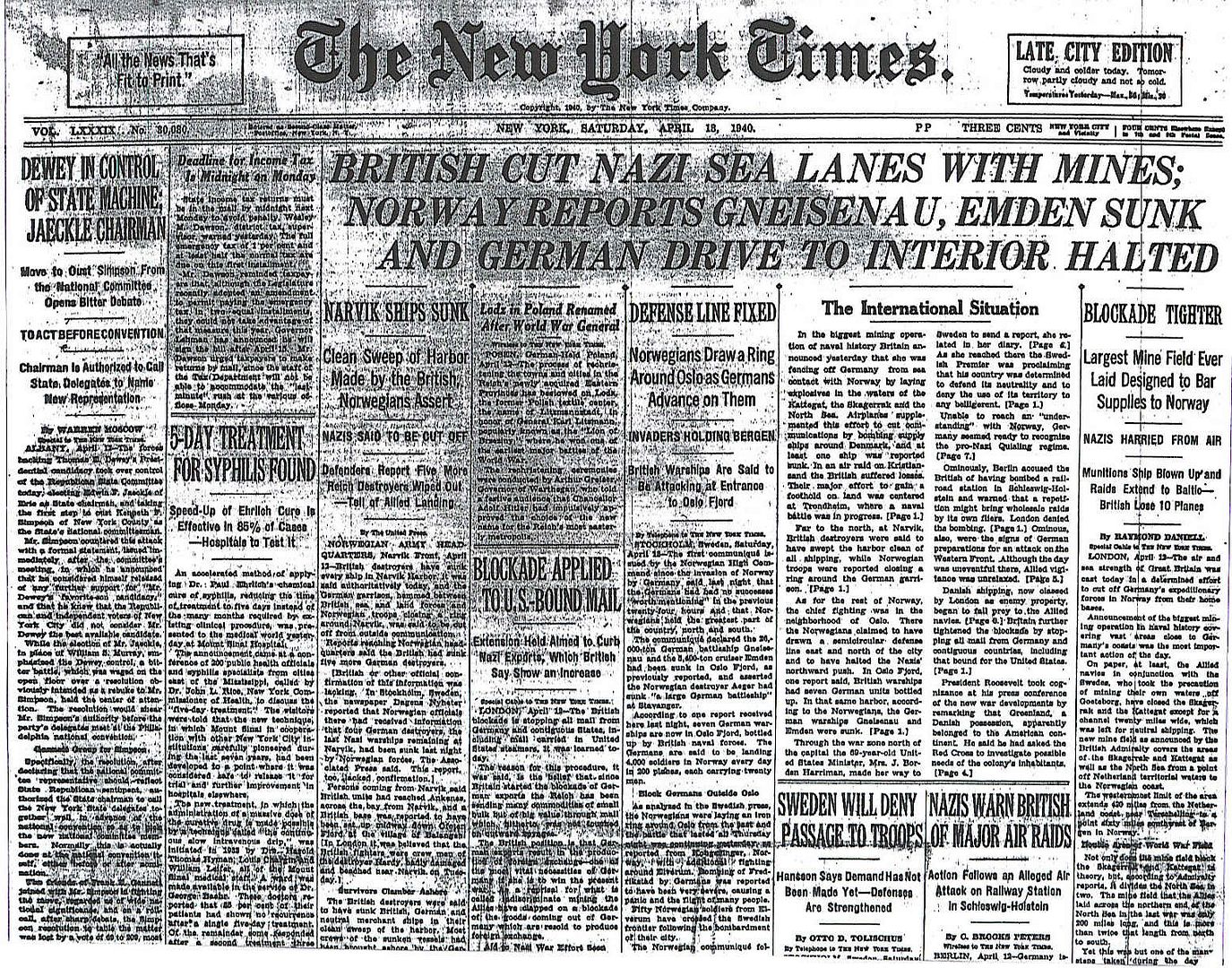
Posted on 04/13/2010 5:56:48 AM PDT by Homer_J_Simpson

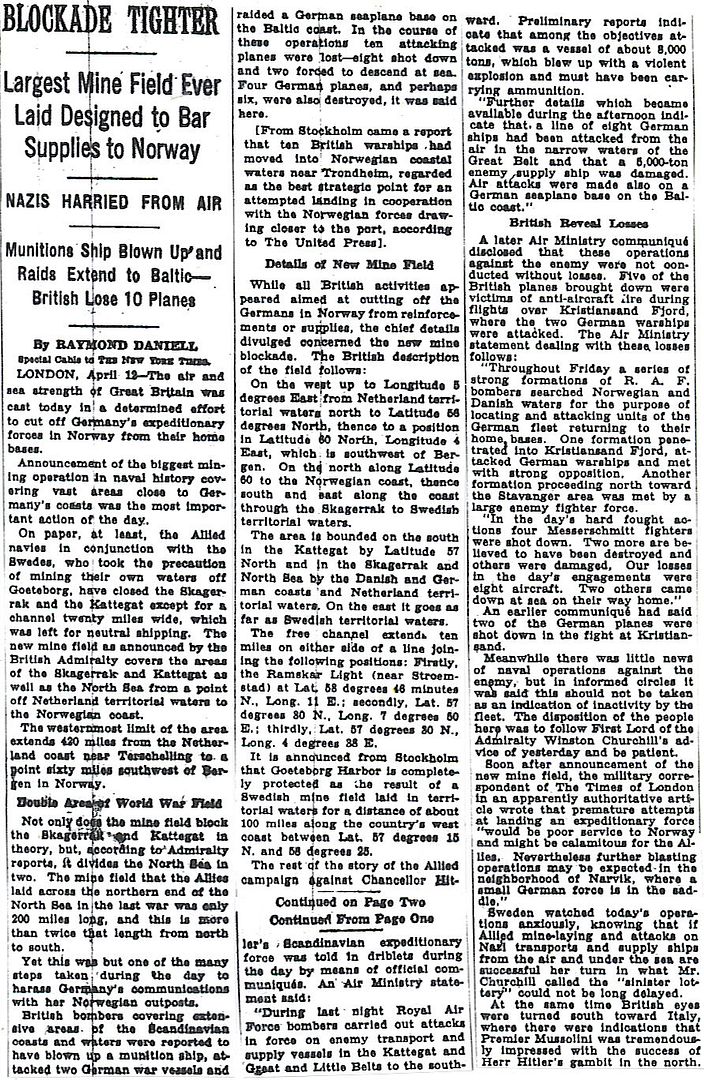
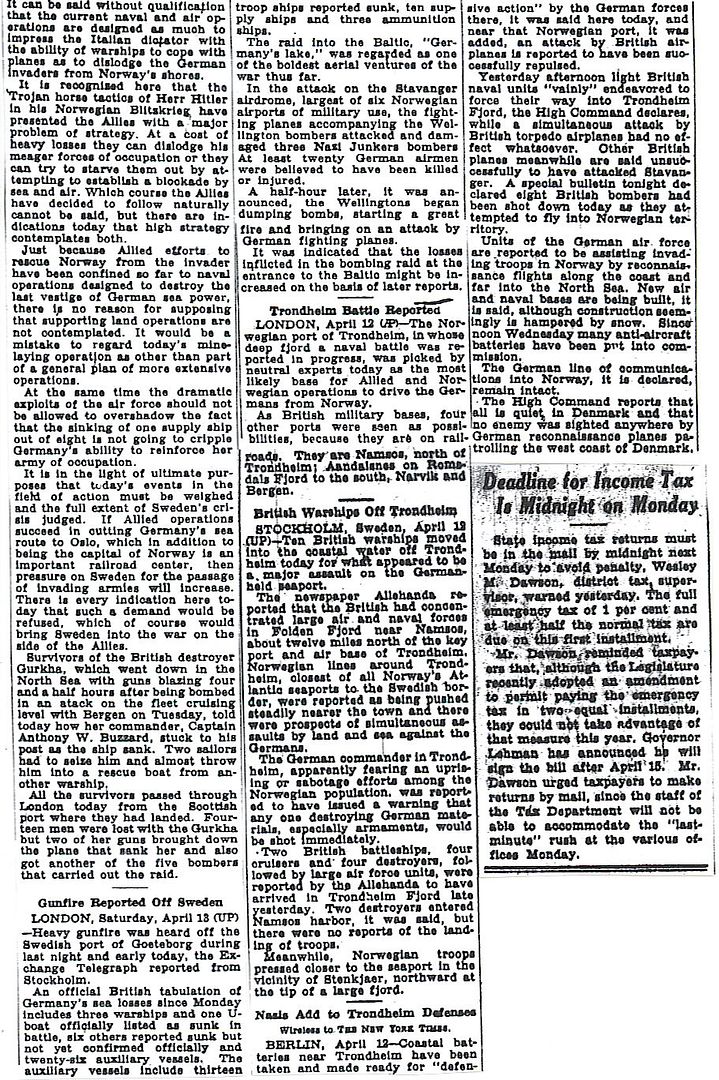
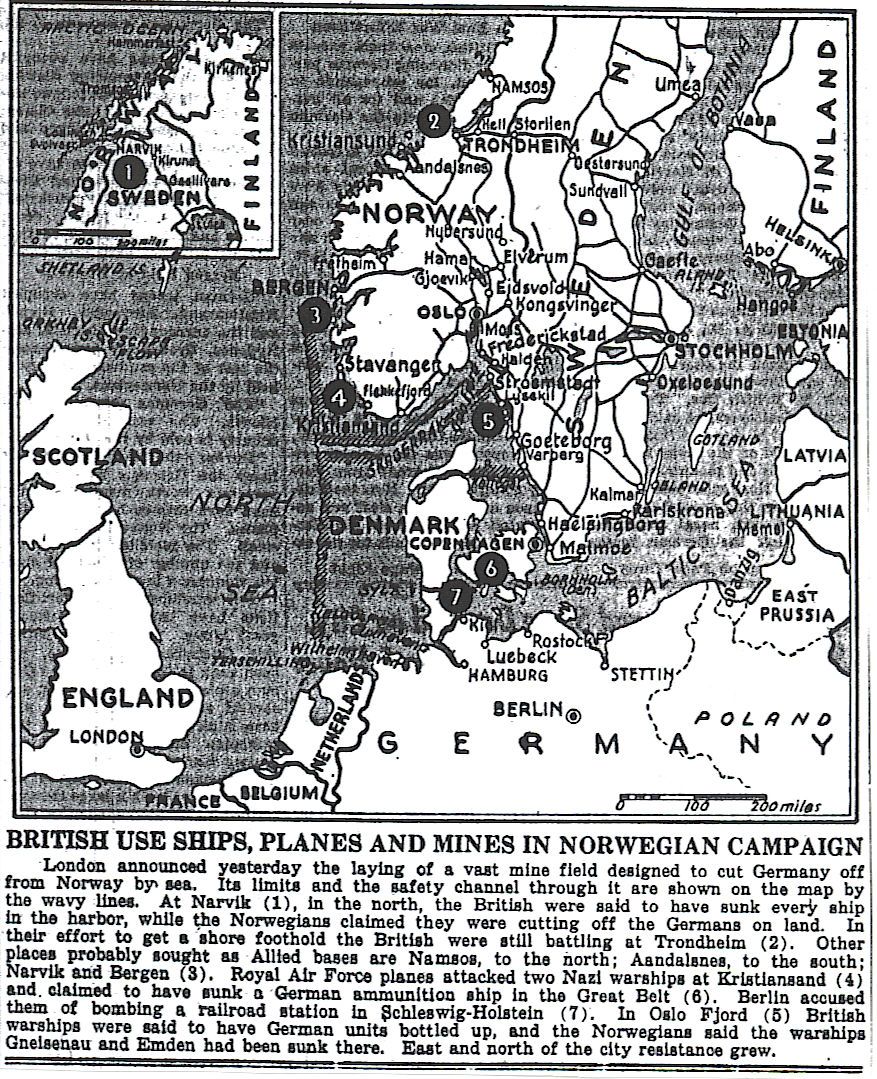
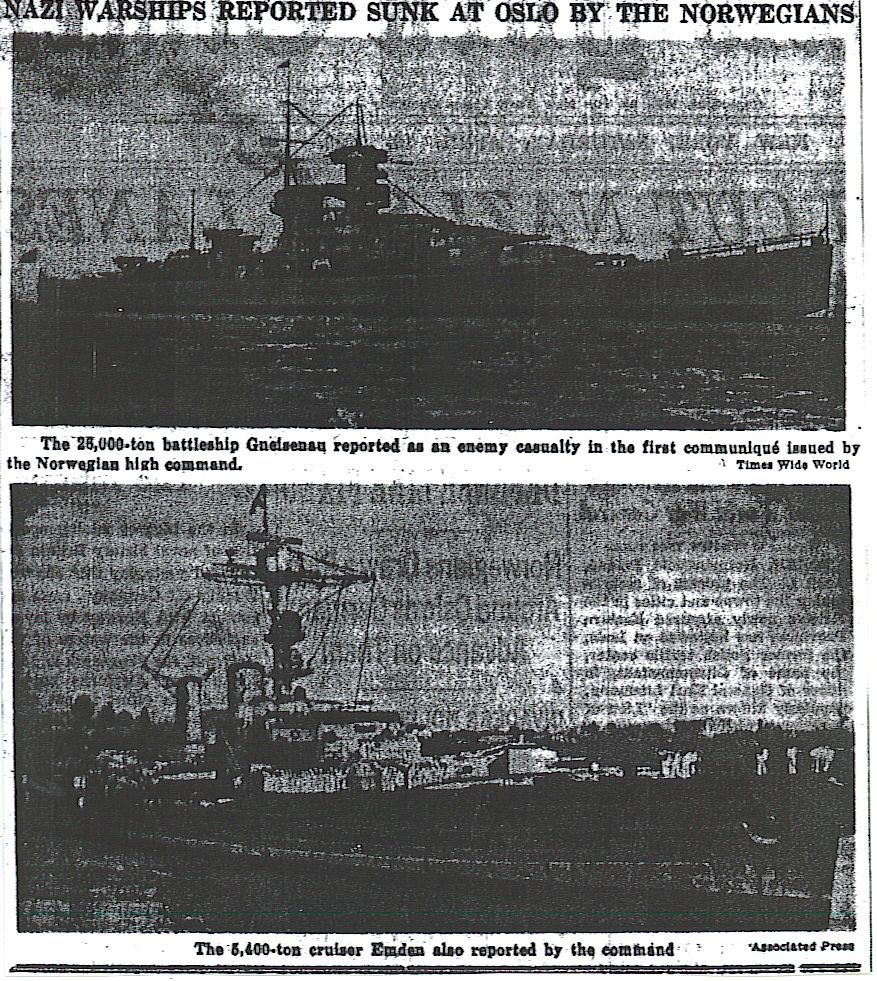
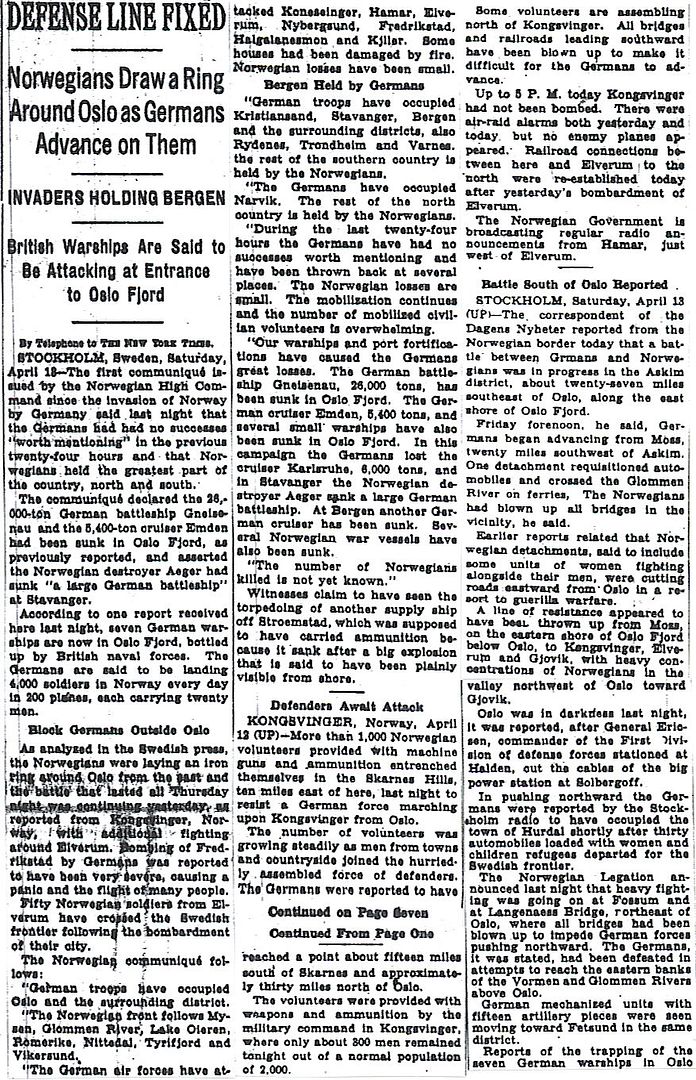
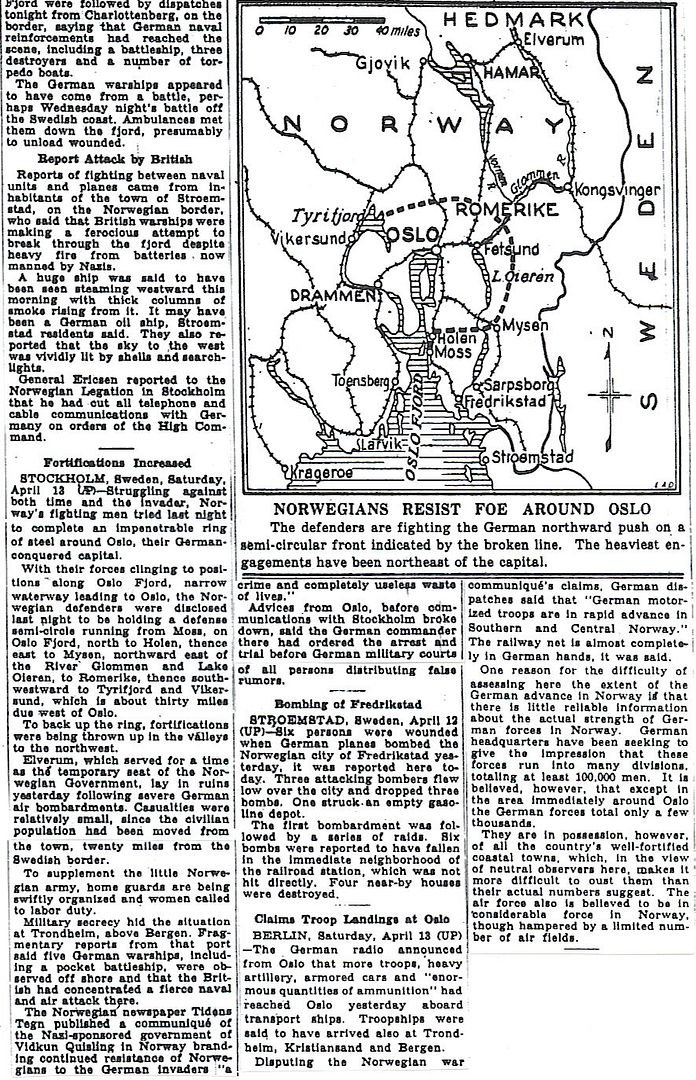
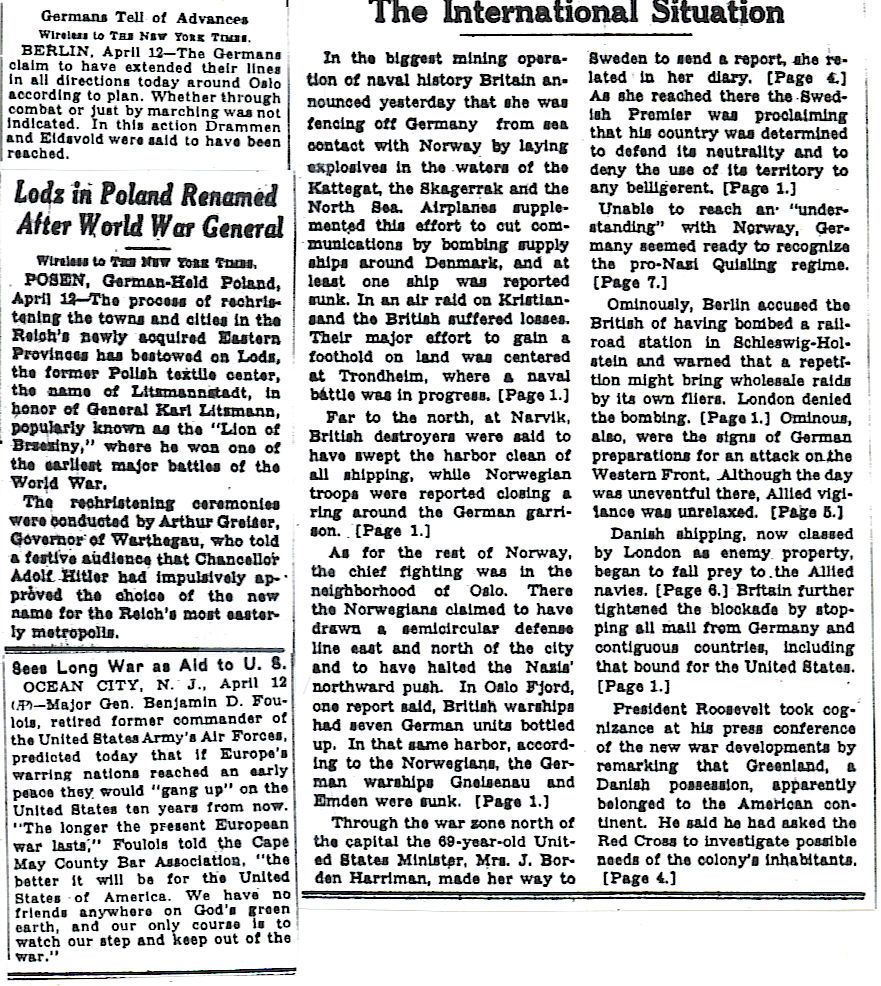
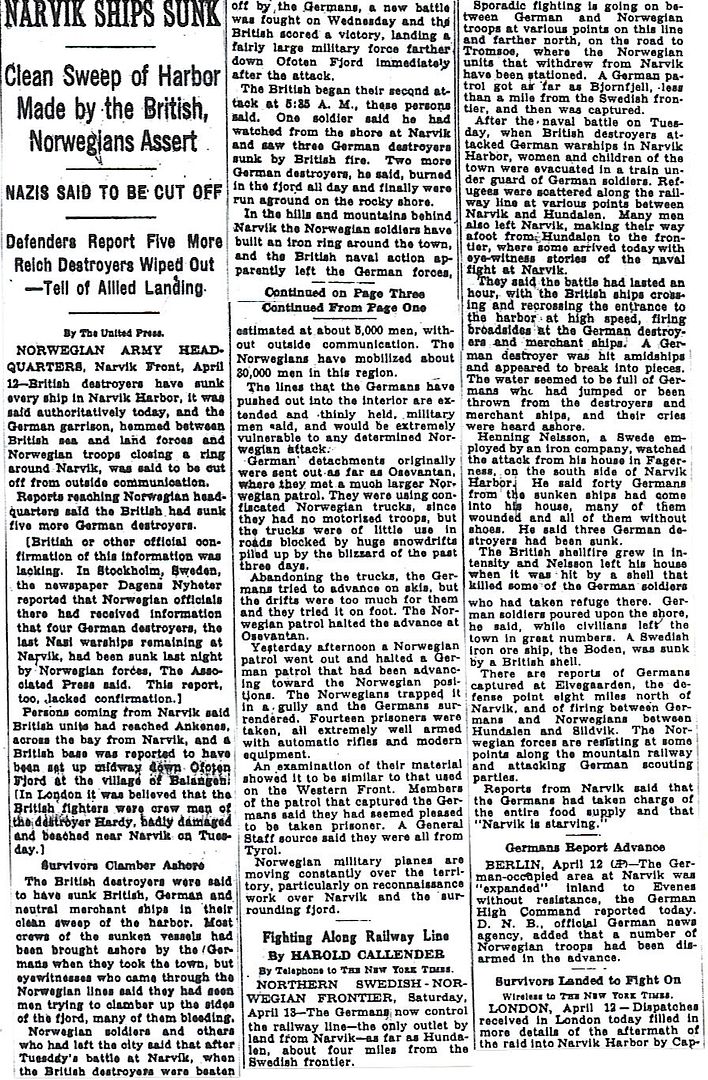
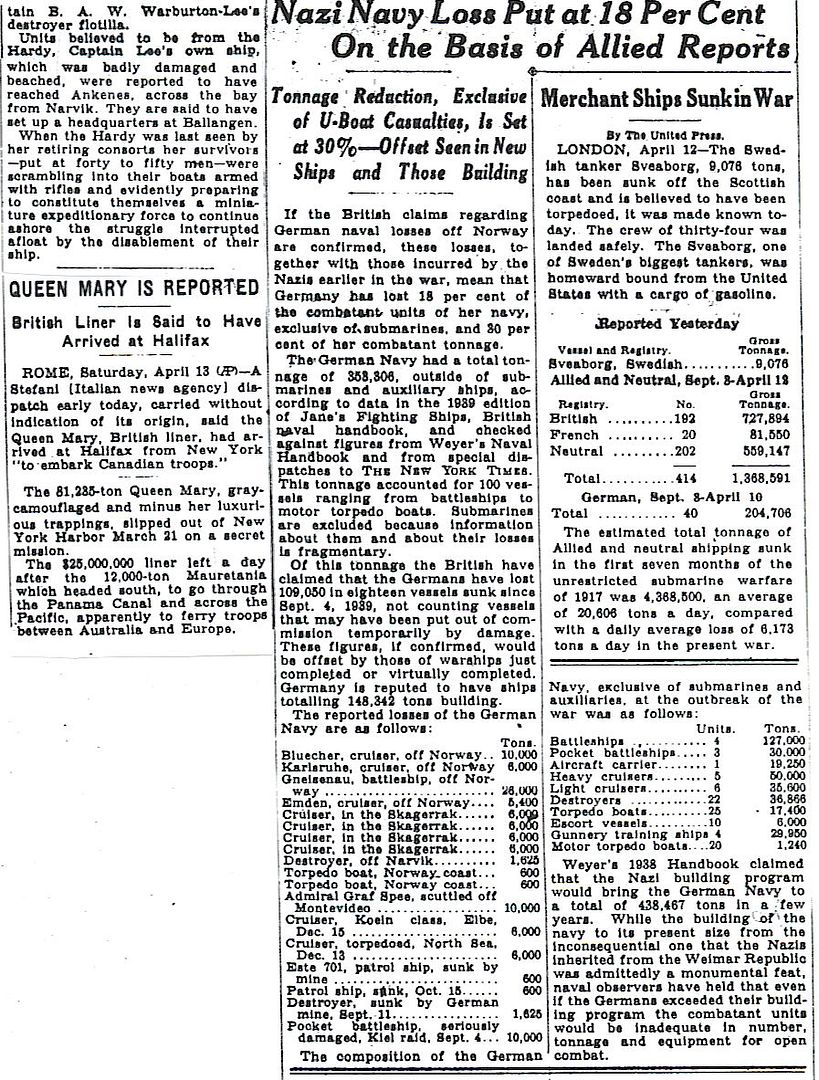
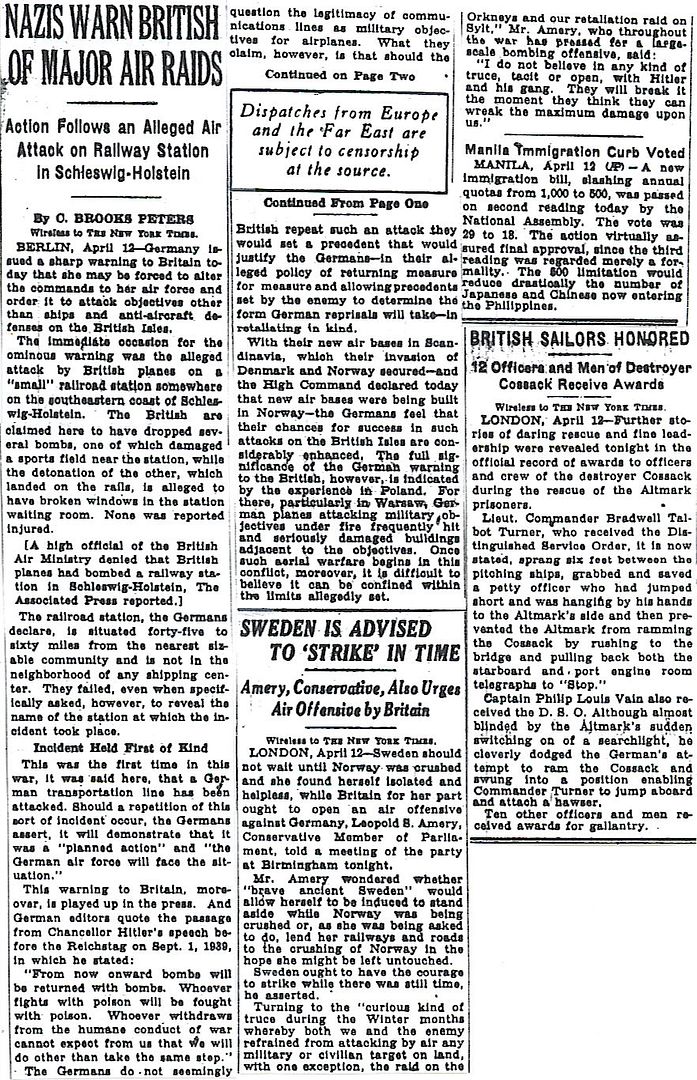
Why would the state government need an emergency 1% of income on top of the normal state income tax? The states weren’t funding the military build up were they?
To paraphrase ark Twain, I think reports of GNIESENAU’s demise are somewhat premature.
While she won’t have the career of her sister ship, GNIESENAU will, I think, be around for awhile longer. She may even show up in Norwegian waters again. Say around Jume...
Was she part of that Channel dash?
http://www.onwar.com/chrono/1940/apr40/f13apr40.htm
Second Royal Navy victory at Narvik
Saturday, April 13, 1940 www.onwar.com
In the Norwegian Sea... The Second Battle of Narvik. All eight German destroyers remaining in the fiord are sunk by a British force which includes the battleship Warspite as well as nine destroyers. A U-boat is also sunk by the Warspite’s scout plane. The German commander, Captain Bey, has missed several opportunities to get at least some of his ships away during the previous few days.
In Berlin... Hitler is very worried by the situation in Norway and is only just prevented by his staff from issuing a series of very rash orders, particularly to the troops in Narvik.
Yes. Along with SCHARNHORST and PRINZ EUGEN.
On April 13, the first British landing on Norwegian soil took place at Namsos, nor of Trondheim, when 350 sailors and marines were put ashore to deny it to the Germans. Later, troops were to use it as a base for 'Operation Maurice', and attack on Trondheim from the north by British and French units. The Germans immediately started bombing it. - The Atlantic Campaign, Dan Van der Vat, p. 158.
This was not the only British landing of the day though.
The German invasion of Denmark and Norway led the British to occupy the Danish Faroe Islands (between the Shetland Isles and Iceland) on April 13th, and response to the new Atlantic threat posed by the German capture of the Norwegian coast, a new boldness (or desperation) was shown with the seizure of neutral Iceland for days before Churchill came to power. - The Atlantic Campaign, Dan Van der Vat, p. 162.
The heavy cruiser Blücher. on the other hand did 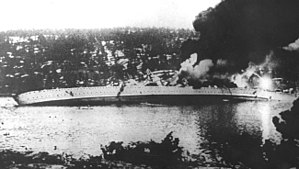
And German navy heavy units looked very similar
Blücher 
Gneisenau 
http://homepage.ntlworld.com/andrew.etherington/month/thismonth/13.htm
April 13th, 1940
FAEROE ISLANDS: An advance guard of Royal Marines is landed with the eventual agreement of the Danish Governor.
DENMARK: The first mines dropped by RAF aircraft are laid in Danish waters.
NORWEGIAN CAMPAIGN: Second Battle of Narvik. HMS Warspite and nine destroyers are sent into the Narvik Fjords to finish off the remaining German ships. U-64 is first of all sunk by HMS Warspite’s Swordfish catapult aircraft scouting ahead. Then the surviving eight German destroyers are all destroyed or scuttled - Bernd von Arnim, Diether von Roeder, Erich Giese, Erich Koellner, Georg Thiele, Hans Ludermann, Hermann Kunne and Wolfgang Zenker. The Royal Navy’s HMS Eskimo and HMS Cossack are damaged.
[8 crew of U-64 survive by self-escaping from the conning tower after sinking. All are rescued by a British destroyer to become PoWs. More are pulled from the water by locally deployed Gebirgsjäger (German mountain troops)]
In an effort to cooperate with the Royal Navy’s assault on the German destroyers trapped in the fjords around Narvik, at 1220 HMS Furious dispatched six Swordfish of 816 Squadron and 4 of 818 Squadron each armed with 4 x 250 pound SAP bombs and 8 x 20 pound Cooper bombs. Visibility of the target area was extremely poor, the cloud base extending down to 500 feet and many rain storms about. After crossing Baroy Island, visibility began to improve and large calibre gun flashes were observed from HMS Warspite. At 1345, the formation split into individual sub-flights to attack several enemy destroyers observed below. The aircraft attacked first with the 250 pounders, then again with the 20 pounders. Two hits were claimed as well as several near misses, though in reality the only tangible result are near misses on the German destroyers Herman Künne (Z-19) and Bernd von Arnim (Z-11) and the sinking of the Norwegian patrol vessel Kelt .
Two aircraft of 818 Squadron were lost; one being shot down - U3C - Sub-Lieutenant(A) Grenville Robert Hampden, RN (P) and Naval Airman first class Raymond Frederick Dale, RN (AG) both being lost, and the other (U3M:L2810) with a badly wounded pilot force-landing ashore with a badly wounded pilot, the crew being saved. (Midshipman (A) D. H. Dammers, RN (P) and Leading Airman A. J. Sturges, RN (AG)) (Mark Horan and Russ Folsom)
Vice-Admiral Whitworth, commanding officer (Naval) wires the Admiralty and urges that since the German troops on shore have been stunned and disorganized - Dietl and his men had in fact taken to the hills - Narvik could be occupied at once ‘by the main landing force’.
The first British troop convoys have by now left the Clyde for Narvik, but some ships are diverted to Namsos. German forces are well-established in the south and centre of Norway and have control of the air. Norway’s remaining armed forces including the units which were guarding the Finnish frontier and some reservists are now under the command of Norway’s new C-in-C, General Otto Ruge, an intellectual reputed to work well under pressure. His strategy is to prevent the main German force now landed at Oslo from linking up with the coastal foothold, by blocking the valleys. Thus the German advance has been punctuated by bloody localised assaults, sending back a stream of casualties amongst Gen. von Falkenhorsts reservists. Falkenhorst’s tactics have been to use his elite 169th Mountain Division to outflank the Norwegian blocks and to apply “aerial artillery” (dive-bombers) against them. General Ruge is unlikely to surrender though, he says, “the defeat or captivity of our forces is better for the nation than their voluntary capitulation.”
Ruge also gets some vital financial help today in the form of 11.1 million Kroner - almost 4.5 million American dollars - Norwegian bank notes. The notes had been spirited out of the Bank of Norway by the driver of the bank’s armoured truck, Rudolph Sandergren. In a daredevil exploit, Sandergren concealed the money in five potato sacks and smuggled it through German lines and roadblocks to the town of Hamar, where he turned it over to Anders Frihagen, Norway’s Minister of Commerce. Today, Frihagen appeared at Ruge’s HQ in Rena and presented him with the money, for use in paying the recruits to his Resistance force and to purchase food and other supplies.
RAF Coastal Command: aircraft reconnoitre the coastal areas of southern Norway. An enemy cruiser and destroyer are seen heading north off the Haugesund area; two enemy cruisers are anchored at Kristiansand South, and a considerable amount of Flak is encountered. Six Hudsons drop bombs on Stavanger airfield during the afternoon and are attacked by Bf110s, one Bf110 is claimed shot down and one damaged.
RAF Bomber Command: Weather prevents a force of Blenheims from attacking German shipping in the Heligoland Bight. During the night Hampdens lay mines in the Kattegat-Kiel area and on the return flight one comes down in the sea.
ITALY and HUNGARY: Rome and Budapest: Italy and Hungary seem to be sliding ever nearer to involvement in the war. In Italy’s case it is only the dictator Mussolini’s fear of the consequences which has kept him out. He has so far not fulfilled his obligation to Hitler under the “Pact of Steel” which committed Italy to go to Germany’s aid with “all its military forces” in time of war.
“I must emphasise to you,” he wrote to Hitler, “that I cannot assume the initiative of warlike operations, given the actual conditions of Italian military preparations.” However, with Germany’s continued military success there are indications the the Duce is preparing to go to war in case he misses any of the spoils.
Hungary’s case is different. It is caught between Russia and Germany and, although its army is reputed to be the best in the Danube basin, its central plain makes ideal tank country.
Every time its giant neighbours move, Hungary trembles. Admiral Horthy, the regent of this kingless kingdom, tries to placate both of them. Soon he may be forced to choose between Nazi Germany and Communist Russia.
MEDITERRANEAN SEA: HMS Ark Royal and HMS Glorious, in company with the destroyers HMAS Stuart, HMS Bulldog, HMS Westcott and HMS Wishard, arrive at Gibraltar. (Jack McKillop)
PANAMA CANAL ZONE: Destroyer USS J. Fred Talbott (DD-247) returns to the Canal Zone after providing medical assistance to passenger on board Japanese steamship SS Arimasan Maru. The warship’s medical officer remains with his patient until the Japanese vessel reaches Balboa. (Jack McKillop)
U.S.A.: Experimental TV station W2XWV in New York City is licensed to the Allen B. DuMont Laboratories. (The station is now WNYW, Channel 5 in New York City.) (Jack McKillop)
Britain places an order for several hundred of the Bell model 14 fighter, later to become the P-39 Airacobra.
The order was for 675 Model 14s which were to be named Caribou. This aircraft differed from the US version in armament which consisted of a 20mm Hispano M-1 cannon in the nose with 60 rounds; two 50-calibre (12.7 mm) machine guns in the nose with 135 rpg; and four 30-calibre (7.62mm) machine guns in the wings with 250 rpg.
This followed a $9 million order for 200 P-39s on 30 March 1940 by the French Government. Deliveries were to begin in October 1940.(Jack McKillop)
Thank you.
http://worldwar2daybyday.blogspot.com/
Day 226 April 13, 1940
2nd Battle of Narvik. British battleship HMS Warspite & 9 destroyers, under Vice-Admiral William Jock Whitworth, enter Ototfjord to destroy the remaining German flotilla at Narvik. A Fairey Swordfish launched from Warspite bombs & sinks U-64 (8 dead, 38 survivors make a free ascent to the surface). Germans lose 8 destroyers; 3 are sunk (100 dead) & 5 scuttled, out of fuel or ammunition. 2600 sailors survive & join General Dietl’s forces in the defense of Narvik. German destroyers shell but do not sink HMS Punjabi (14 dead, 28 wounded) & HMS Cossack, which runs aground (9 dead, 21 wounded). HMS Eskimo’s bow is blown off by a German torpedo but she does not sink. Whitworth signals London that the Germans are beaten & Narvik can be taken with a single Brigade. http://www.battleguide.net/Narvik.htm
The 38 survivors from U-64 are rescued by German mountain troops. Out of respect, the crew will adopt the Edelweiss as the emblem for their new submarine U-124 when they are reassigned in June 1940. http://www.uboat.net/special/emblems/u124.html
Norwegian Cruiser-minelayer HNoMS Frøya, protecting the fortress of Agdenes at Trondheim, is damaged by German warships and beached. U-34 administers a coup de grâce to prevent salvage.
British War Cabinet dithers between landings at Trondheim, to help secure southern Norway from German advance, and the original strategic goal of Narvik to interfere with Swedish iron ore traffic. Churchill presciently warns of “the grave danger that we should find ourselves committed to a number of ineffectual operations along the Norwegian coast, none of which would succeed”.
Major difference is the number of turrets, and guns per turret. SCHARNHORST and GNIESENAU were the only Germabn ships with three turrets with three guns each [HIPPER class heavy cruisers and BISMARCK class battleships had four turrets of two guns each, the DEUTSHLAND Panzerschiffes had two turrets of thrre guns each].
Interestingly, SCHARNHORST and GNIESENAU were designed to allow replacement of her main guns [11”x9] with nine 15” guns. Would have made WW II in the Atlantic more interesting if the conversion had been done.
Thanks to Admin Moderator, that great American, for correcting the title to this thread, which I originally dated as 3/13/40. No wonder it got low traffic.
You’re welcome!
Disclaimer: Opinions posted on Free Republic are those of the individual posters and do not necessarily represent the opinion of Free Republic or its management. All materials posted herein are protected by copyright law and the exemption for fair use of copyrighted works.